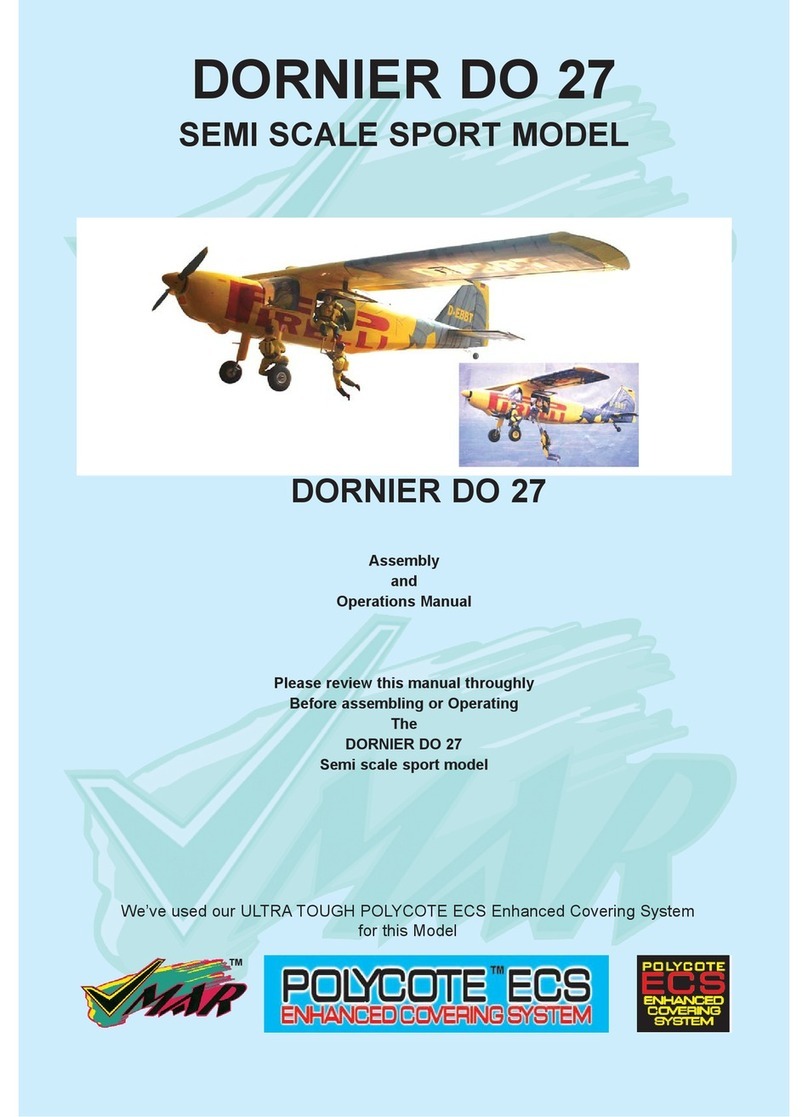710
10A- Nose gear assembly 10C- Nose gear assembly installed to
the fuselage (side view)
10B- Insert the nose gear steering
control arm to the EZ connector then
insert the nose gear assembly into
the nose gear bearing then tighteng
the control arm screw
11C- Front and rear motor mount
11F- Mount the brushless motor to
the front motor mount
11I- Mount the brushless motor to the
rear motor mount
11G-The front motor mount with the
motor install to the nose
11H- Cowl,propeller and spinner are
installed to the nose
11H- Cowl,propeller and spinner
installed to the rear end
11D- Front motor location 11E- Read motor mount location
11B- The pair of the suitable ESC come with motor
11A- Front and rear brushless motors are same 150 watts
brushless motor recommended
INSTALL THE NOSE GEAR
STAGE 10
INSTALLING THE ELECTRIC MOTOR AND ESC
STAGE 11
Control arm screw
Front motor mount
Rear motor mount
EZ connector
E
S
C
E
S
C
11G-The rear motor mount with the
motor install to the rear end
CONFIRM RADIO OPERATION
STAGE 18
Step 18.1 Consult your radio manual for instructions about
testing and operating your radio system.
Step 18.2 Pay particular attention to charging your batter-
ies and range testing your system before and after each
flight.
Step 18.3 Check that all controls are working correctly
before and after each flight.
BALANCING THE AIRCRAFT
STAGE 19
Step 19.1 The CG for your DO 335 is located at 3.1/2 in to
4 in (87mm - 102mm) back from the leading edge of the
wing when the wing has been attached to the fuselage as
per illustration 20A.
Step 19.2 For the initial flight, the CG should be located at
3.1/2 (87mm) back from the leading edge of the wing when
the wing has been attached to the fuselage.
Step 26.3 The CG is measured with the engine,radio gear
and all other components installed
Step 26.4 Set up the CG as it will be when you fly it.
Step 26.5 It is very important to have the CG correct. Flying
your model with the CG too far back will likely lead to loss
of control and a crash. If you discover that after you have
assembled your model and installed your radio, motor and
battery that the CG of your model is incorrect you must
bring the CG to the correct location by doing the following
BEFORE FLYING :
- Move the battery pack fore or aft
- Move other components fore or aft
- Change engine to a lighter or heavier model
- Add weight to the nose or tail. If adding it to the nose,try
to make it useful by going to a heavier duty engine or
adding a spinner with a heavy metal backing plate. As a last
resort, add stick on “dead” weight where appropriate
CONFIRM MECHANICAL INTEGRITY
STAGE 20
Step 20.1 Once you have confirmed that the
CG is correct, you should do a thorough review
of the entire model before your first flight.
Check everything twice! Every hook up, every
coupling, everything! Do it twice!!
Step 20.2 Before your first flight, have an
experienced flyer review your work. Do not fly
your model until it has been checked out by a
third party who knows how to fly and how to
set up a model aircraft. Do not fly alone. Seek
experienced help.
Step 20.3 Once you have completed your first
flight, get in the habit of checking your model over
before and after each flight! Don’t fly if you find
something that is not right!
3.1/2in (152mm)
4in (102mm)
27A - CG location
CONTROL SURFACE THROW SPECIFICATIONS:
The throws are measured at the widest part of the control
surface. Adjust the position of the pushrods at the control
and/or servo horns to control the amount of throw. You may
also use ATV's if your radio has them but the mechanical
linkages should still be set so that the ATV's are near 100%
for best servo resolution.


























